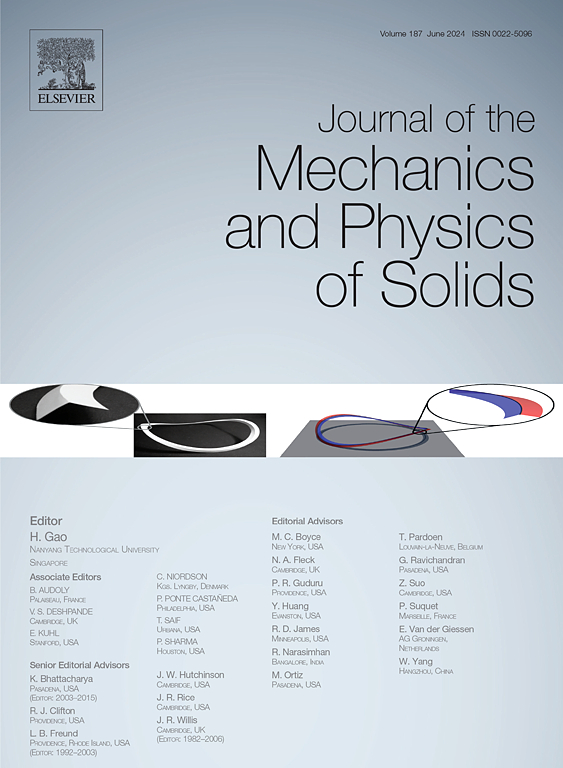仙人掌树枝脱落模型
IF 5
2区 工程技术
Q2 MATERIALS SCIENCE, MULTIDISCIPLINARY
引用次数: 0
摘要
在进化过程中,各种功能原理已经进化,使植物能够为空间上确定的器官脱落创造预定的断点。在仙人掌植物家族中,一些物种,如圆柱仙人掌,具有脆弱的枝-枝连接,用于营养繁殖,而在其他物种中,如无花果-indica,它们非常稳定。这些连接点的断裂行为已经在解剖学和力学上得到了彻底的表征,这些数据是仙人掌启发相场模拟的先决条件。我们发现,由均质材料或具有低弹性模量对比的材料系统组成的模型(类似于圆柱untia bigelovii)表现出一种断裂模式,其中裂缝起源于连接缺口的表皮。相比之下,具有高弹性模量对比的非均质材料体系(类似于无花果)显示沿内部维管束的断裂成核,最大断裂能增加了2.2倍。在高对比度的非均质模型中,v形缺口和真皮组织(“周皮”)的硬化对其断裂行为的影响可以忽略不计。此外,这些模型的断裂形态与实验中发现的粗结断裂部位相似。关于几何影响和整体系统中单个材料力学性能对比的重要性的知识可以作为功能原理转移到仿生工程复合材料中,以便对其断裂行为进行编程。本文章由计算机程序翻译,如有差异,请以英文原文为准。

Modeling abscission of cacti branches
During evolution, various functional principles have evolved that allow plants to create predetermined breaking points for the spatially defined abscission of organs. In the plant family of cacti, some species, such as Cylindropuntia bigelovii, have fragile branch–branch junctions that serve vegetative reproduction, while in other species, such as Opuntia ficus-indica, they are very stable. The fracture behavior of these junctions has been thoroughly characterized anatomically and mechanically, the data being the prerequisite for the performance of cactus-inspired phase field simulations. We have found that models composed of homogeneous materials or material systems with low elastic modulus contrast (analogous to Cylindropuntia bigelovii) exhibit a fracture mode where cracks initiation occurs at the epidermis of the junction notch. In comparison, heterogeneous material systems with high elastic modulus contrast (similar to Opuntia ficus-indica) show fracture nucleation along the inner vascular bundles, with an increase in the maximum fracture energy by a factor of 2.2. In the high contrast heterogeneous models, the V-notch and stiffening of the dermal tissue (“periderm”) have a negligible effect on their fracture behavior. In addition, the fracture morphologies of these models resemble the rough junction fracture sites found experimentally. The knowledge gained about the geometric influences and the importance of the contrasts in the mechanical properties of the individual materials in the overall system can be transferred as functional principles to bioinspired engineering composites in order to program their fracture behavior.
求助全文
通过发布文献求助,成功后即可免费获取论文全文。
去求助
来源期刊
CiteScore
9.80
自引率
9.40%
发文量
276
审稿时长
52 days
期刊介绍:
The aim of Journal of The Mechanics and Physics of Solids is to publish research of the highest quality and of lasting significance on the mechanics of solids. The scope is broad, from fundamental concepts in mechanics to the analysis of novel phenomena and applications. Solids are interpreted broadly to include both hard and soft materials as well as natural and synthetic structures. The approach can be theoretical, experimental or computational.This research activity sits within engineering science and the allied areas of applied mathematics, materials science, bio-mechanics, applied physics, and geophysics.
The Journal was founded in 1952 by Rodney Hill, who was its Editor-in-Chief until 1968. The topics of interest to the Journal evolve with developments in the subject but its basic ethos remains the same: to publish research of the highest quality relating to the mechanics of solids. Thus, emphasis is placed on the development of fundamental concepts of mechanics and novel applications of these concepts based on theoretical, experimental or computational approaches, drawing upon the various branches of engineering science and the allied areas within applied mathematics, materials science, structural engineering, applied physics, and geophysics.
The main purpose of the Journal is to foster scientific understanding of the processes of deformation and mechanical failure of all solid materials, both technological and natural, and the connections between these processes and their underlying physical mechanisms. In this sense, the content of the Journal should reflect the current state of the discipline in analysis, experimental observation, and numerical simulation. In the interest of achieving this goal, authors are encouraged to consider the significance of their contributions for the field of mechanics and the implications of their results, in addition to describing the details of their work.

 求助内容:
求助内容: 应助结果提醒方式:
应助结果提醒方式:


